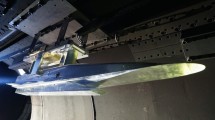Abstract
In this work, a systematic methodology is applied, leading to an accurate prediction of the dynamic response of a complex vehicle, carrying a superstructure. This methodology helps in locating areas of the superstructure exhibiting a large stress concentration, for given loading conditions, without requiring any knowledge of the dynamic characteristics of the vehicle suspension subsystem. The basic idea is to first measure the acceleration time histories at the connection points of the vehicle superstructure with its suspension system and use them subsequently as a base excitation in a finite element model of the superstructure. More specifically, the vehicle superstructure is first discretized by appropriate finite elements. The resulting model is linear and is then updated through an experimental measurement of its dynamic response, yielding all the elements of the corresponding frequency response matrix of the superstructure. Then, a series of experimental trials is performed in real operating conditions, aimed at recording the acceleration time histories at the connection points of the superstructure with the chassis. These time histories are subsequently used as a ground excitation for the finite element model of the superstructure and the stresses developed under the specific loading conditions are evaluated. In this way, the critical points of the superstructure can be identified by numerical means. Finally, the reliability of the methodology applied was tested by two numerical examples as well as by placing strain gauges at the critical points of the superstructure and performing a new set of measurements for the vehicle under similar loading conditions. Direct comparison of the numerical and experimental data obtained in this manner verified the reliability and accuracy of the hybrid methodology applied.




















Similar content being viewed by others
References
Craig RR Jr (1981) Structural Dynamics—An Introduction to Computer Methods. J Wiley & Sons, New York
Craig RR Jr (1987) A review of time-domain and frequency domain component mode synthesis methods. Int J Anal Exp Modal Anal 2:59–72
Vermot des Roches G, Bianchi JP, Balmes E, Lemaire R and Pasquet T (2010) Using component mode in a system design process, Proceedings of the IMAC-XXVIII 2010, Jacksonville, Florida, USA
Papalukopoulos C, Natsiavas S (2007) Dynamics of large scale mechanical models using multi-level substructuring. ASME J Comput Nonlinear Dyn 2:40–51
Verros G, Natsiavas S (2002) Ride dynamics of nonlinear vehicle models using component mode synthesis. ASME J Vib Acoust 124:427–434
Craig RR Jr (1977) Methods of component mode synthesis. Shock Vib Dig J 9:3–10
Klosterman A (1972) A combined experimental and analytical procedure for improving automotive system dynamics. SAE Tech Pap 720093
Craig Jr RR and Chang CJ (1977) Substructure coupling for dynamic analysis and testing, Technical report CR2781. NASA
MacNeal RH (1971) A hybrid method of component mode synthesis. J Comput Struct 1:581–601
Bennighof JK, Kaplan MF (1998) Frequency window implementation of adaptive multi-level substructuring. ASME J Vib Acoust 120:409–418
Farhat C, Geradin M (1994) On a component mode synthesis method and its application to incompatible structures. Comput Struct 51:459–473
Cuppens K, Sas P, Hermans L (2000) Evaluation of FRF based substructuring and modal synthesis technique applied to vehicle FE data, ISMA 2000. K.U. Leuven, Belgium, pp 1143–1150
Huizinga ATMJM, van Campen DH, Kraker A (1997) Application of hybrid frequency domain substructuring for modelling an automotive engine suspension. ASME J Vib Acoust 119:304–310
Jetmundsen B, Bielawa RL, Flannelly WG (1988) Generalized frequency domain substructure synthesis. J Am Helicopter Soc 85:55–64
Ren Y, Beards CF (1995) On substructure synthesis with FRF data. J Sound Vib 185:845–866
Giagopoulos D, Natsiavas S (2007) Hybrid (numerical-experimental) modeling of complex structures with linear and nonlinear components. Nonlinear Dyn 47:193–217
Giagopoulos D and Natsiavas S (2013) Dynamic analysis and identification of critical points in the superstructure of a vehicle through FE modeling and mobility tests, Proceedings of the ASME IDETC/CIE 2013, Portland, Oregon, USA
Chen C, Ricles JM, Karavasilis TL, Chae YY, Sause R (2012) Evaluation of a real-time hybrid simulation system for performance evaluation of structures with rate dependent devices subjected to seismic loading. Eng Struct 35:71–82
Gao X, Castaneda N, Dyke SJ (2013) Real time hybrid simulation: from dynamic system, motion control to experimental error. Earthq Eng Struct Dyn 42:815–832
Papadimitriou C, Ntotsios E, Giagopoulos D, Natsiavas S (2012) Variability of updated finite element models and their predictions consistent with vibration measurements. Struct Control Health Monit 19:630–654
Giagopoulos D, Papadioti D-Ch, Papadimitriou C and Natsiavas S (2013) Bayesian uncertainty quantification and propagation in nonlinear structural dynamics, Proceedings of the IMAC-XXXI 2013, Garden Grove, California, USA
DYNAMIS 3.1.1, Solver Reference Guide, DTECH, Thessaloniki, Greece, 2013
MSC.NASTRAN (2008) Quick Reference Guide, MSC.SOFTWARE, 2008.
Mottershead JE, Friswell MI (1997) Model updating in structural dynamics: a survey. J Sound Vib 167:347–375
Ewins DJ (1984) Modal Testing: Theory and Practice. Research Studies Press, Somerset
Mohanty P, Rixen DJ (2005) Identifying mode shapes and modal frequencies by operational modal analysis in the presence of harmonic excitation. Exp Mech 45:213–220
Spottswood SM, Allemang RJ (2007) On the investigation of some parameter identification and experimental modal filtering issues for nonlinear reduced order models. Exp Mech 47:511–521
Richardson MH and Formenti DL (1985) Global curve fitting of frequency response measurements using the rational fraction polynomial method, Third IMAC Conference, Orlando, Florida
Kerschen G, Golinval JC, Hemez FM (2003) Bayesian model selection for the identification of nonlinear mechanical structures. ASME J Vib Acoust 125:389–397
National Instruments Corporation, http://www.ni.com
Acknowledgments
This research was supported by a grant from the Hellenic Vehicle Industry (ELVO S.A.).
Author information
Authors and Affiliations
Corresponding author
Rights and permissions
About this article
Cite this article
Giagopoulos, D., Natsiavas, S. Dynamic Response and Identification of Critical Points in the Superstructure of a Vehicle Using a Combination of Numerical and Experimental Methods. Exp Mech 55, 529–542 (2015). https://doi.org/10.1007/s11340-014-9966-z
Received:
Accepted:
Published:
Issue Date:
DOI: https://doi.org/10.1007/s11340-014-9966-z




